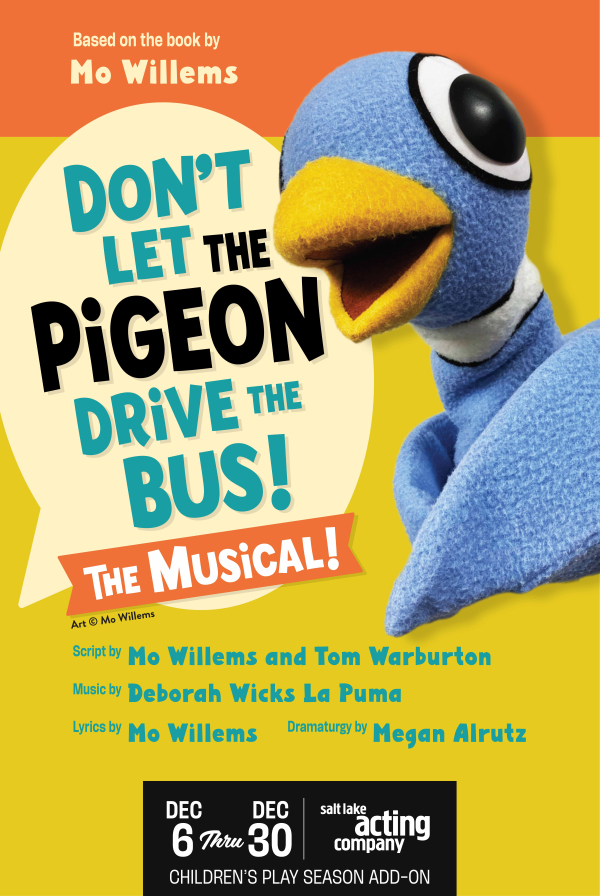Give a hand to Salt Lake Acting Company's Hand to God
by Andrea Fife | April 27,2017
Book-ended by monologues contemplating the nature, origin, and roles of basic Christian tenets of good, evil, the devil, and salvation, Hand to God tells the stories of a teenage boy Jason and his mother Margery as they each struggle to cope with the respective loss of father and husband. While Margery seeks reprieve through an illicit relationship with a student in her church-sponsored puppetry class, Jason confronts his issues through his outspoken and painfully direct puppet Tyrone. Set entirely in the classrooms and offices of a Lutheran church, the vein of religion woven strongly through this Robert Askins script is matched only by the pervasive theme of sexuality explored between not only between the human characters in the story but by the puppets as well.
Show closes May 14, 2017.
As three of the five actors in this Salt Lake Acting Company production belong to the Actors’ Equity Association, I set my expectations high. I was delighted to have even such high expectations surpassed in so many specific ways. From Amy Ware‘s first appearance on the stage as Jessica, Ware had the turned-in toes and slouched shoulders that so often define being a teenage girl. The brightly mismatched patterns of her leggings and blouse, product of Philip R. Lowe‘s costume design, provided a poignant contrast to her diminuative expressions and timid movements. As Timothy, a troubled teen with his romantic sights set firmly on Jason’s mother, Nathan Vaughn brought the brooding intensity, charisma, and misplaced confidence needed to convincingly seduce an adult woman. In turn, Alexandra Harbold exuded a desperate realism through Margery’s conversations with Pastor Greg (played by Daniel Beecher) and Jason as she tried to share her fear and loneliness after losing her husband. In only one moment throughout the evening did I feel the façade crack: the passion between Margery and Timothy felt forced with kisses and caresses that appeared choreographed, especially with the intimate proximity of the audience to the stage.
In the many frantic exchanges delivered by Riley O’Toole, whose job required him to switch continuously from portraying the character of Jason to voicing and animating his puppet Tyrone, Askins appears to have embedded an early opportunity for O’Toole to showcase his puppetry aplomb. Delivering a segment of the Abbott and Costello classic “Who’s on First” at breakneck speed, O’Toole quickly establishes an important aspect of this production: that he is able to be both Jason and Tyrone simultaneously and that the audience should accept each independently. I was most impressed in the moments when O’Toole had to respond with the facial expressions and natural reactions of Jason while voicing Tyrone’s angry outbursts. To play either character convincingly seems a feat; to play both simultaneously showcases O’Toole as a master of his craft.
The entire production was supported by other masterfully executed details as well. The set, designed by Gage Williams, reminded me of a Transformer action figure, with moving pieces that could be configured and reconfigured to transform the space from the church activity room to the pastor’s office. Most of the lighting transitions were subtle and effective, supporting the idea that the job of light designer James M. Craig may well go unnoticed unless something goes wrong. However, in a perfectly timed combination of light and sound effect (the latter designed by Jennifer Jackson), headlights moved past a window as a car approached the church building. This brief moment was an indication of the level of detail attended to throughout the development of this production.
Director Christopher DuVal was given a difficult task of coordinating the violent exchange between Jason and Tyrone that occurs late in the plot as Jason tries to free himself from Tyrone’s erratic control. As Jason tore Tyrone from his hand and flung him across the room, Tyrone crashed into the wall and slid to the floor, leaving a bloodied smudge behind as evidence of the violent exchange. Quickly discovering Tyrone’s evil still rooted deeply in his own hand, Jason turns a hammer toward himself. Despite my best efforts to the contrary, I closed my eyes tightly and my stomach churned as Margery stepped in between her son and the hammer’s claw. When I convinced myself to again open my eyes, both were covered in blood and engulfed in a tension unparalleled by any of my live theatre experiences to date. In short, it was too much for me. And in being too much seemed to be the exact level the scene demanded.
Through violence and sexuality this production throws a spotlight onto the origin of evil, and the webs woven among characters and puppets effectively explore the central idea of Tyrone’s opening and closing monologues. However, it wasn’t the message of the piece that stuck with me through the drive home and through my evening conversations; I just want O’Toole and Tyrone to finish “Who’s on First.”














